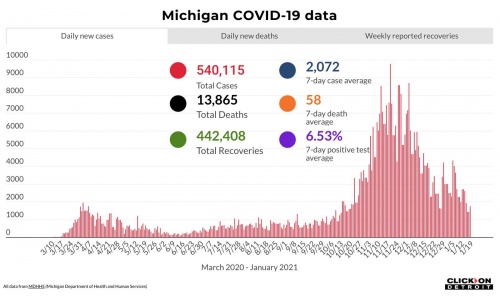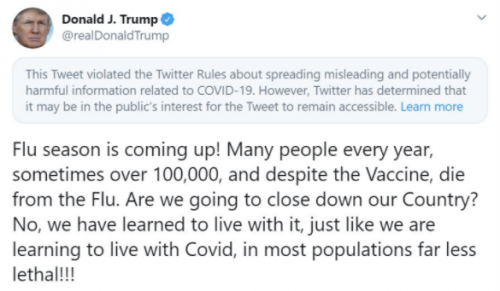Disinformation of the COVID-19 Pandemic
Contents
Introduction
COVID-19
COVID-19 is a respiratory disease caused by a novel coronavirus that causes symptoms such as shortness of breath, fever, cough, etc.[1] The World Health Organization (WHO) identified it as a new type of coronavirus after China reported an outbreak in December 2020.[1] Most coronaviruses are not dangerous, however, the infections from COVID-19 have ranged from mild to deadly.[1] The disease mainly affects those who are 65 and older along with people with underlying health conditions, but there is still plenty left to discover about the disease. [2] It is mainly spread through person to person contact from respiratory droplets that come from coughing, sneezing, or talking.[3] As a result, a major way of combatting the virus is limiting in person contact and communication. Researchers are still uncertain what caused the COVID-19 variant, but coronaviruses are common in humans and animals including bats, camels, cats, and cattle. However, since the COVID-19 strain is similar to the strains of MERS and SARS, the origin is believed to have come from bats.[1]
COVID-19 Pandemic

On March, 11 2019, the World Health Organization declared the COVID-19 crisis a global pandemic. [5] In the months following the shutdown, the entire United States was shut down to help prevent the spread of the virus in an unprecedented move. This caused the economy of the United States to come to a halt and caused the worst recession seen since the Great Recession of 2009.[6] The lockdown caused a great deal of controversy as small businesses everywhere struggled to stay afloat without being able to open their doors to the public. As states wished to reopen their economies, the information about the Coronavirus such as new case numbers, new death tolls, and testing positivity rates in certain areas were vital to arguments of each side of the aisle. Because this data was important to each argument, there were instances of it being skewed to fit different agendas.
Controversy and Conspiracies of COVID-19
Anti-Masking
As said above, a major way that COVID-19 spreads is through respiratory droplets. According to the CDC, masks are effective at preventing spreading and contracting the virus by filtering out viruses particles from the air. [7] Although this method has proven to reduce the spread of the virus, there are those who are against using them because they see them making it more difficult to breathe or see them as the government infringing on their freedoms. [8] Proponents of this behavior have tried to spread disinformation about the pandemic, pushing information that makes COVID-19 as a minimal threat despite overwhelming evidence in the opposite direction.
COVID-19 Vaccination
Since COVID-19 spread through the United States, the development of an effective vaccine has been at the center of attention around this pandemic. The development of this vaccine was called "Operation Warp Speed," and the vaccine is now being distributed all over the United States. However, despite much testing and no evidence of bad long term effects, a recent survey showed that only 50-70% of United States citizens wish to receive the vaccine. [9] It has been estimated that about 70-90% of the population will need to receive the vaccine to reach herd immunity. [10] Much of the concern surrounding the vaccine has to do with the speed at which it was approved and produced. However, there have also been some conspiracy theories about the vaccine such as the vaccine being developed so that Bill Gates would be able to put microchip trackers in a large portion of the population through the vaccine. [11] With no evidence or logic behind the conspiracy theory, there is fear that the narrative will slow the United States goal of herd immunity.
The Spread of Disinformation
As the pandemic continued, so did the confusion around it. The spread of disinformation on the internet increased rapidly during the pandemic, and it was mainly caused by an increase in the use of information technologies, especially social media. This led to more people having distrust in the information they saw, making it harder to create policies that did not have large backlash. [12]
Social Media
The issue of disinformation spread on social media is a complicated one. On one hand, social media platforms serve as a place where people can speak freely about any topics they choose. However, these platforms now have to balance allowing an open forum for speech and discussion and protecting the spread of disinformation. Otherwise, false information can spread quickly to a large audience of people. As these platforms continue to grow, there is a growing responsibility to fact check posts, especially large ones, to limit the spread of disinformation. [13]
Donald J. Trump

One of the main spreaders of disinformation was President Donald J. Trump, who often downplayed the risks of COVID-19 on Twitter. His account was eventually banned from the Twitter platform due to his tweets and its outcomes, mainly the Capitol riot in January. After this action by the social media company, the amount of disinformation online about COVID-19 among other issues dropped by about 73 percent.[15] Throughout his presidency, one of Trump's main goals was to build up the American economy. Because the pandemic and its subsequent shutdown threatened this, Trump wanted to downplay the severity of the pandemic. He did this through his Twitter often, tweeting out false information. [15] Additionally, Trump often referred to the COVID-19 virus as the "China Virus," which was shown to increase the use of anti-Asian hashtags on Twitter. [16] This is especially prevalent because of the shooting that occured on March 16, 2021 in Atlanta Georgia. Six of the eight victims were Asian. [17] This is one example of the dangers of disinformation. One of Trump's tweets downplaying the pandemic is shown on the right.
Helicopters Spraying Disinfectant
During March 2020, there were stories that helicopters were going to fly over neighborhoods and spray disinfectant in the air to kill the virus and end the spread.[18] This claim originated in India, Mexico, and Switzerland, and eventually spread to the United States. The information was shared through text messages over WhatsApp before spreading through multiple social media platforms. This is another piece of disinformation that was started and spread surrounding the hysteria that was the beginning of the COVID-19 pandemic. In particular, residents of New York City received texts that warned them to close their windows and doors as the disinfectant would be in the air after 11:00 p.m. This caused New York City Council Speaker Corey Johnson to address these rumors over Twitter and deny the validity of the information.[18]
5G Spreading COVID-19
In late January 2020, Facebook posts that claimed 5G technology was responsible for the emergence of the COVID-19 started circulating around the internet.[19]This was around the same time the first cases of COVID-19 were recorded in the United States. The posts either claimed that 5G weakened the immune system and allowed people to be more susceptible to the virus, or 5G technology had the potential to transmit the virus. According to University of Reading’s Dr. Simon Clarke, however, the claims are unfounded. The associate professor in microbiology states the immune system can be weakened by many factors, and 5G radio waves are not included as they are not strong enough to heat people enough to affect them in any capacity. Clarke claims that viruses and electromagnetic waves are “as different as chalk and cheese.” One flaw to this specific conspiracy theory is that COVID-19 is being spread in specific areas of countries like the United Kingdom and Iran that do not have 5G access yet.[19]
References
- ↑ 1.0 1.1 1.2 1.3 Coronavirus and COVID-19: What You Should Know. (2013, August 7). WebMD. https://www.webmd.com/lung/coronavirus
- ↑ Weekly Updates by Select Demographic and Geographic Characteristics. (2021, March 24). CDC. https://www.cdc.gov/nchs/nvss/vsrr/covid_weekly/index.htm
- ↑ Coronavirus. (2020, January 10). World Health Organization. https://www.who.int/health-topics/coronavirus
- ↑ Bartkowiak, D. (2021, January 19). Coronavirus in Michigan: Here’s what to know Jan. 19, 2021. Click On Detroit. https://www.clickondetroit.com/health/2021/01/19/coronavirus-in-michigan-heres-what-to-know-jan-19-2021/#//
- ↑ Taylor, D. (2021, March 17). A Timeline of the Coronavirus Pandemic. New York Times. https://www.nytimes.com/article/coronavirus-timeline.html
- ↑ Mordecai, M., & Schumacher, S. (2020, September 22). In many countries, people are more negative about the economy amid COVID-19 than during Great Recession. Retrieved March 27, 2021, from https://www.pewresearch.org/fact-tank/2020/09/14/in-many-countries-people-are-more-negative-about-the-economy-amid-covid-19-than-during-great-recession/
- ↑ CDC. (n.d.). Masks protect you & me. Retrieved March 27, 2021, from https://www.cdc.gov/coronavirus/2019-ncov/prevent-getting-sick/masks-protect-you-and-me.html
- ↑ How One Doctor Addresses Doubts from Anti-Maskers. (2021, November 19). Health Essentials. https://health.clevelandclinic.org/how-one-doctor-addresses-doubts-from-anti-maskers/
- ↑ Galewitz, P. (2021, January 27). Poll: Nearly half of American adults now want the Covid vaccine - ASAP. Retrieved March 27, 2021, from https://khn.org/news/article/poll-nearly-half-of-american-adults-now-want-the-covid-vaccine-asap/
- ↑ McCallum, K. (2020, December 30). Herd Immunity: How Many People Need to Get the COVID-19 Vaccine? Houston Methodist. https://www.houstonmethodist.org/blog/articles/2020/dec/herd-immunity-how-many-people-need-to-get-the-covid-19-vaccine/
- ↑ Agley, J & Xiao, Y. (2021) Misinformation about COVID-19: evidence for differential latent profiles and a strong association with trust in science. BMC Public Health. https://bmcpublichealth.biomedcentral.com/articles/10.1186/s12889-020-10103-x
- ↑ Butcher, P. (2021, January 25). COVID-19 as a turning point in the fight against disinformation. Nature Electronics. https://www.nature.com/articles/s41928-020-00532-2
- ↑ Sweeney, C. (2021, February 9). Fighting the Spread of COVID-19 Misinformation. Harvard School of Public Health. https://www.hsph.harvard.edu/news/features/fighting-the-spread-of-covid-19-misinformation/
- ↑ Falcon, R. (2020, October 6). Twitter flags Trump tweet comparing flu to COVID-19 as ‘misleading’ and ‘potentially harmful’. KXAN. https://www.kxan.com/news/coronavirus/twitter-flags-trump-tweet-comparing-flu-to-covid-19-as-misleading-and-potentially-harmful/
- ↑ 15.0 15.1 Dwoskin, E & Timberg, C. (2021, January 16). Misinformation dropped dramatically the week after Twitter banned Trump and some allies. Washington Post. https://www.washingtonpost.com/technology/2021/01/16/misinformation-trump-twitter/
- ↑ Kurtzman, L. (2021, March 18). Trump’s ‘Chinese Virus’ Tweet Linked to Rise of Anti-Asian Hashtags on Twitter. UCSF. https://www.ucsf.edu/news/2021/03/420081/trumps-chinese-virus-tweet-linked-rise-anti-asian-hashtags-twitter
- ↑ Chen, N. (2021, March 22). Xiaojie Tan owned 2 spas and planned to retire soon. Then she became one of the Atlanta gunman's first victims. CNN. https://www.cnn.com/2021/03/21/us/metro-atlanta-shootings-sunday/index.html
- ↑ 18.0 18.1 Helicopters not spraying disinfectant over neighborhoods to stop virus. (2020, March 24). AP NEWS. https://apnews.com/article/8682190618
- ↑ 19.0 19.1 Lawrie, E. S. R. B. (2020, April 15). Coronavirus: Scientists brand 5G claims “complete rubbish.” BBC News. https://www.bbc.com/news/52168096